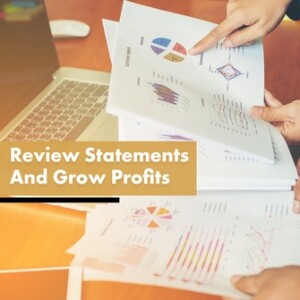Episodes

Friday Jan 12, 2024
Friday Jan 12, 2024
Improving financial performance for your business involves a crucial step: regularly Title: Review Your Profit And Loss, Balance Sheet, and Cash Flow Statements and Why You Need To do This Monthly
Every business owner dreams of success and growth. However, achieving these goals requires more than just hard work and determination. It involves understanding the financial health of your business and taking proactive steps to ensure its prosperity. In this article, we'll delve into the critical practice of regularly reviewing your Profit and Loss (P&L) statement, Balance Sheet, and Cash Flow statements, and why this should be a monthly ritual.
The Scorecard for Your Business
Profit and Loss (P&L) Statement
Think of your P&L statement as the scorecard for your business. It provides a clear picture of how much money your business has made (revenue) and how much it has spent (expenses) over a specific period, typically a month. This simple document is your window into your business's financial performance.
Imagine you own a bakery. Your P&L statement will reveal your monthly revenue from selling delicious pastries and the costs of ingredients, labor, and rent. If you notice that your expenses consistently exceed your revenue, it's a clear sign that adjustments are needed. Perhaps you're splurging on premium ingredients or staffing too generously during slower hours. Regularly reviewing your P&L statement allows you to spot such issues early and take corrective action.
Balance Sheet
The Balance Sheet is like a snapshot of your business's financial health at a particular point in time. It consists of two primary sections: assets and liabilities. Assets encompass everything your business owns, such as cash, equipment, or inventory. Liabilities, on the other hand, represent what your business owes, including loans or outstanding bills. The Balance Sheet also provides insight into your business's equity, which is the residual interest in assets after deducting liabilities.
Returning to our bakery example, your Balance Sheet will display the cash you have in the bank, the value of your baking equipment, and any outstanding loans or bills. This snapshot helps you gauge your overall financial position. If you notice that your liabilities are growing faster than your assets, it's time to reassess your expenses or explore ways to increase revenue.
Cash Flow Statement
The Cash Flow statement is all about tracking the movement of money into and out of your business. Picture it as following the flow of water in a river. This statement breaks down your cash inflows (like customer payments) and outflows (like rent and supplier payments) over a set period, typically a month. Its primary purpose is to help you determine if your business has enough cash to cover its expenses.
In our bakery scenario, your cash flow statement can reveal if you experience cash shortages during certain months. If you find yourself struggling to pay bills on time due to inconsistent cash flow, it might be necessary to adjust your pricing, offer promotions, or negotiate better terms with suppliers.
Implementing Financial Mastery in Your Business
Understanding the importance of reviewing these financial statements is just the first step. To truly benefit from this practice, you need to know how to implement it effectively. Here's how:
1. Set a Monthly Routine: Treat financial reviews as essential appointments. Block out dedicated time on your calendar each month to go over your financial statements. Consistency is key.
2. Use Accounting Software: Invest in reliable accounting software or consider hiring a professional accountant. These tools can help you generate accurate and efficient financial statements, saving you time and potential errors.
3. Analyze Trends: Don't just glance at the numbers; scrutinize them for trends. Look for recurring issues or opportunities for improvement. Identifying patterns can guide your decision-making.
4. Compare to Previous Months: To gain valuable insights, compare your current month's statements to the previous month's or the same month from the previous year. This will help you spot seasonal patterns or anomalies that require attention.
5. Seek Professional Advice: If you're unsure how to interpret the statements or need guidance in making financial decisions, consider consulting with a financial advisor or accountant. Their expertise can be invaluable in navigating complex financial matters.
6. Take Action: Identifying areas that need improvement is essential, but taking action is where the magic happens. Adjust your pricing, cut unnecessary expenses, or explore new revenue streams based on your findings.
7. Track Progress: Continuously monitor the impact of the actions you take. Are your changes leading to better financial performance? If not, be prepared to adjust your strategy as needed.
In conclusion, regularly reviewing your Profit and Loss, Balance Sheet, and Cash Flow statements is akin to monitoring your business's vital signs. It empowers you to make informed decisions, identify problems early, and steer your business toward greater financial success. Just as you wouldn't embark on a long trip without checking your car's dashboard, make reviewing these statements a monthly habit for the health and prosperity of your business.
Remember, financial mastery is a journey, not a destination. By staying committed to this practice, you'll be better equipped to achieve your business growth aspirations.
To gain access to strategies specifically made for business owners, visit jetresult.today/get. There's a lot to learn – valuable ideas, energizing live sessions, coaching, and more – all in a community commited to growing revenue, profit, cash flow, business value, and personal lifestyle.
#GrowProfits #Profits #FinancialStatements #BusinessGrowth #NicClark #Jetresult


No comments yet. Be the first to say something!